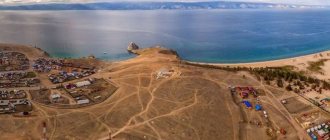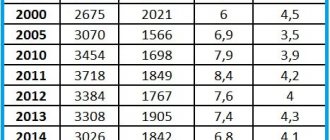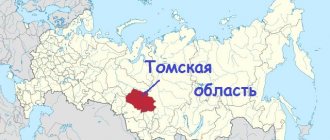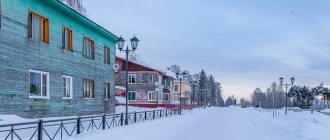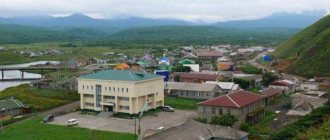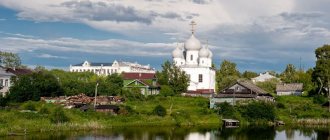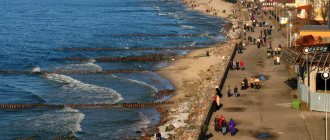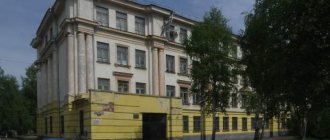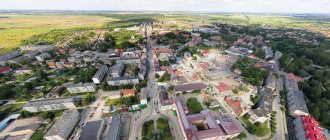What holiday is it today?
January 22, 2022, Saturday
Today are holidays, events: Day of Unification of Ukraine Tomorrow: Premiere of the opera “Eugene Onegin” at the Bolshoi Theater
Today is the Orthodox holiday: Martyr Polyeuctus. St. Philip, Metropolitan of Moscow and All Russia, wonderworker... Tomorrow: St. Gregory, Bishop of Nyssa. Venerable Markian the presbyter. Venerable Dometian, Bishop of Melitino. St. Paul of Komel, wonderworker, student of St. Sergius of Radonezh. Saint Theophan, the Recluse of Vyshensky...
Today is a national holiday: St. Philip's Day... Tomorrow: Gregory - Summer Guide...
Seasons
Seasons, four periods of the year (spring, summer, autumn and winter) characterized by certain average temperatures. The period during which the Sun passes through one of these sectors is called the season. Spring in the Northern Hemisphere and autumn in the Southern Hemisphere begin when the Sun passes through the initial circle of declination and its right ascension is 0° (vernal equinox). Summer in the Northern Hemisphere and winter in the Southern Hemisphere occur when the sun's right ascension is 90° (summer solstice). Autumn in the Northern Hemisphere and spring in the Southern Hemisphere begin when the sun's right ascension is 180° (autumnal equinox). The beginning of winter in the Northern Hemisphere and summer in the Southern Hemisphere is considered to be the winter solstice, when the direct ascension of the Sun is 270°... Next: Seasons. Russian folk calendar. Monthly words...
Folk calendar about every day
Every day one season always replaces another and this determines a person’s way of life. In connection with this, a folk calendar was formed in which there were practically no nameless, unmarked days. Every day was special, had its own purpose. All this was determined by climate conditions and astrological phenomena.
A calendar is a system for counting periods of time. The first calendars arose a long time ago, in ancient times, because there was a need to measure time. The word calendar comes from the Latin words caleo - to proclaim and calendarium - debt book. This is due to the fact that in Ancient Rome the beginning of each month was especially proclaimed, and because it was customary to pay debts on the first day of the month. Different peoples counted time differently. Some calendars are based on the changing phases of the moon - lunar calendars; in others - the change of seasons - sunny; in others, the length of the year was coordinated with the change of seasons, and the counting of months was associated with the phases of the Moon. Such calendars are called lunisolar.
In Rus', the calendar was called a monthly calendar. Every day, the month book covered the entire year of peasant life, “describing” day by day, month after month, where each day had its own holidays or weekdays, customs and superstitions, traditions and rituals, natural signs and phenomena. The cyclical nature of the calendar is reminiscent of human life, where spring is youth, summer is heyday, autumn is the time of harvesting fruits (it’s good if there are some, otherwise you can live your life without collecting fruits), winter is the time of wisdom and peace. This cyclicality and rhythm determined the way of life of the farmer. The folk calendar was an agricultural calendar, which was reflected in the names of the months, folk signs, rituals and customs. Even the determination of the timing and duration of the seasons is associated with real climatic conditions. Hence the discrepancy between the names of the months in different areas... Next: Folk calendar...
Some more facts about Kaliningrad
What time zone is Kaliningrad in?
Kaliningrad time differs by −1 hour from Moscow time. That is, if in Moscow it is 12 o’clock in the afternoon, then in Kaliningrad it is 11 o’clock in the morning. This is standard time throughout the Kaliningrad region.
What is the sea like in Kaliningrad? Kaliningrad is washed by the Baltic Sea. Thanks to this, there are several small resort towns in the Kaliningrad region: Svetlogorsk, Zelenogradsk, Pionersky. Here we wrote in more detail about the features of a beach holiday in Kaliningrad. And here are the prices for holidays in Kaliningrad during the season.
What climate zone is Kaliningrad located in? Due to the fact that Kaliningrad is located on the shores of the Baltic Sea, its climate is influenced by the Gulf Stream. Winter here is much warmer than in mainland Eurasia. Summer is not too hot, which is optimal for people who cannot tolerate heat.
At what latitude is Kaliningrad? Kaliningrad is located at latitude 54 degrees and 42.4434 minutes. This parallel is called the “golden” parallel because it lies almost halfway between the north pole and the equator. It is believed that these latitudes have the most suitable amount of solar heat and daylength for life. The longitude of Kaliningrad is 20 degrees and 30.43842 minutes
What cities are near Kaliningrad? The border with Poland is approximately 50 km. large away . The capital of Poland, Warsaw , is 350 km away. The capital of Lithuania, Vilnius , is 340 km away. The capital of Germany, Berlin , is 620 km away. All these cities are accessible within a few hours by car. The Mediterranean Sea is approximately 1500 km or a couple of days by car.
Fishing calendar for every day
The fishing calendar should not be taken as an absolutely indisputable truth. Fish biting is greatly influenced by a whole range of natural factors, as well as the influence on the nature of man himself. You must not forget that the fish’s bite depends and is determined not only by the calendar dates and biological cycles of their life, reflected in the calendar, but also, no less, by the state of their habitat; the bite also depends on weather conditions: air and water temperatures, cloudiness, wind direction and strength, etc... Next: Fishing calendar...
Attractions
The main attraction of modern Kaliningrad is the cathedral and Kant Island. In addition, here you can see several magnificent ancient gates and German churches. In Soviet times, Kaliningrad was built up with typical high-rise buildings, with surviving fragments of historical buildings adjacent to them. Significant areas of pre-war German architecture have been preserved only in Amalienau, Ratshof and Maraunenhof (in fact, these are suburbs of Königsberg, where cottages of wealthy citizens were built in the 19th and early 20th centuries).
Kant Island (Kneiphof)
Kant Island
Kant Island or Kneiphof is one of the oldest places in Kaliningrad. In the Middle Ages, a settlement arose here, which soon received city rights, and then became part of Königsberg. The island now houses the city's most iconic landmark, the cathedral. The grave of the famous philosopher Immanuel Kant is also located here.
Once upon a time this island, formed by the Pregolya branches, was the real heart of Königsberg. Kneiphof was the spiritual and commercial center of the city, built up with three hundred houses. The island was connected to the rest of Königsberg by five bridges. Kneiphof was destroyed in 1944 by British air raids. After Kaliningrad became part of the USSR, the ruins of buildings were removed to rebuild Leningrad.
Cathedral
The Cathedral is a symbol of modern Kaliningrad. It was built in the 14th century in the brick Gothic style. It was originally a Catholic Church, which became Lutheran after the Reformation. Currently, the cathedral is not a functioning religious building and is used for museum exhibitions and concerts. Unfortunately, the rich interior of the church was destroyed by bombing. But the building itself survived. During Soviet times, the cathedral was in a deplorable state and was completely restored only in the 2000s.
Many believe that the cathedral was preserved only thanks to Kant’s grave. Kant's works were highly appreciated by Lenin. Therefore, during Soviet times, the ruins of the ancient church, located next to the grave of the great philosopher, were decided to be left alone.
The first cathedral in Königsberg was built by 1302 and was located in the southwestern part of Altstadt. Very quickly it became too small for the growing city. Ultimately, the Master of the Teutonic Order allocated a site for the construction of a new cathedral on the island of Kneiphof. And in 1333 construction began. The building material for the new church building was brick obtained from the demolition of the old cathedral. Also for the construction, new gates were made within the walls of Alstadt and a temporary bridge was built. Interestingly, the Cathedral Gate eventually stood for 6 centuries and was destroyed by bombing in 1944. The new cathedral was completed in 1380.
Opposite Kant Island, on the banks of the Pregolya, there is the “Fish Village” - a modern complex of buildings in the style of traditional German architecture. This stylized “piece” of old Königsberg is now a popular attraction in Kaliningrad.
Königsberg city gate
In Kaliningrad, 7 city gates have survived to this day. All of them were built in the 19th century and are now important architectural monuments.
Brandenburg Gate
The Brandenburg Gate was built in the 17th century on the road leading to Brandenburg Castle. The current building, in brick neo-Gothic style, dates from the first half of the 19th century and is located on the border of the historic district of Haberberg. The gate is still used for its intended purpose.
Royal Gate
The Royal Gate was built in Kaliningrad in the 19th century on the site of the medieval Kalthof Gate, which was demolished in the first half of the 18th century. They resemble a small castle and are a striking example of neo-Gothic architecture. The Royal Gate is decorated with bas-reliefs of King Otakar II of Bohemia (left), King Frederick I of Prussia (center) and Duke of Prussia Albrecht I (right), installed in three niches. Nowadays a branch of the Museum of the World Ocean is located here.
Friedland Gate
Friedland Gate is another brick neo-Gothic landmark of Kaliningrad, dating back to the 19th century. Nowadays the museum of old Königsberg is located here.
Rossgarten Gate
The Rossgarten Gate was built in the second half of the 19th century on the site of the first fortified ramparts of Königsberg, dating back to the 17th century. They have beautiful battlements and small neat turrets. Now there is a restaurant here.
Friedrichsburg Gate
The Friedrichsburg Gate is a powerful fortification built in 1852 in the neo-Gothic style. Now within these walls there is a branch of the Museum of the World Ocean.
Sackheim Gate
The Sackheim Gate was built in the mid-19th century and for some time served as a checkpoint at the entrance to the city. Moreover, the first gate on this site was erected back in the 17th century and was part of the old fortified ramparts.
Don Tower
The Don Tower is part of the surviving 19th century fortifications that houses the Amber Museum. This powerful fortification forms a single architectural ensemble with the Rossgarten Gate. During the assault on Königsberg, the garrison of this tower was the last to surrender.
Churches of Kaliningrad
Cathedral of Christ the Savior
Cathedral of Christ the Savior is an Orthodox cathedral, which is the architectural dominant of Victory Square. The temple was consecrated in 2006 and built in the traditional Russian-Byzantine style. It is topped with six domes and a belfry.
Juditten
Juditten is a Gothic church founded in the second half of the 13th century by the Teutonic Knights. This is the oldest (surviving) building in Kaliningrad. Now it is part of an Orthodox convent.
Queen Louise Memorial Church
The former Church of Queen Louise is a neo-Romanesque historical building with Art Nouveau elements, built at the beginning of the 20th century. Originally there was a Lutheran church here. Nowadays there is a puppet theater within its walls.
Ponart
Ponart is a neo-Gothic brick church built at the end of the 19th century. Since 1992 it has been an Orthodox Church of the Nativity of the Blessed Virgin Mary.
Former Church of the Holy Family
The former Church of the Holy Family is a beautiful neo-Gothic building built at the beginning of the 20th century according to the design of Friedrich Heitmann. In 1945, the church was seriously damaged and was practically in ruins until the 80s of the 20th century. Restored in 1982 as the city philharmonic.
Holy Cross Cathedral
Holy Cross Cathedral is an Orthodox church located in the building of a former Lutheran church. This Art Nouveau building was built in the 40s of the 20th century.
Church of St. Adalbert
St. Adalbert's Church is a small neo-Gothic chapel built at the beginning of the 20th century in Amalienau. Now there is an administrative building here, which belongs to the Institute of Terrestrial Magnetism
Other sights and interesting places in Kaliningrad
Victory Square
Victory Square is one of the central squares of Kaliningrad, which was previously called Hanseatic. Until the beginning of the 20th century, city fortifications were located in its place.
For tourists with children, the local zoo is a great place to visit. The zoo in Kaliningrad is one of the oldest and largest in Russia. It was founded in the 19th century. There are more than 300 species of animals here. For botany lovers, we recommend going to the botanical garden, where 2,500 species of plants from various places on the planet are collected.
Königsberg Stock Exchange
Königsberg Stock Exchange is one of the most beautiful civil buildings of modern Kaliningrad, built on the banks of the Pregolya in the second half of the 19th century in the neo-Renaissance style.
The Curonian Spit is one of the most beautiful natural attractions of the Kaliningrad region. This narrow strip of land with sand dunes, pine forests and wonderful sea views stretches from Zelenogradsk to Klaipeda, Lithuania.
Synagogue
The New Synagogue is a Jewish religious building built in 2018 on the site of an older 19th-century synagogue that was destroyed during World War II.
Museum of the World Ocean
The Museum of the World Ocean is one of the most interesting museums in Kaliningrad, which is entirely dedicated to the sea. Ships and deep-sea vehicles, equipment and finds recovered from the seabed are presented here.
Amalienau
Amalienau is a former suburb of Königsberg, which before World War II was built up with villas for wealthy citizens. Significant areas of historical buildings have been preserved here to this day. This is one of the most atmospheric places in modern Kaliningrad.
Orthodox calendar about every day
Orthodox calendar: Orthodox, Church and Christian holidays.
The church year is an alternation of weekdays and holidays. On weekdays, a person is called to work “by the sweat of his brow to earn his bread.” Holidays are given in order to feel liberation, to rise above the bustle and routine of the world, to feel involved in the highest of worlds, “where there are no illnesses, sorrows and sighs, but endless life.” Since ancient times, holiday cycles have been associated with the seasons. The pagans associated them with the worship of the forces of nature, the cult of which in the Old Testament was replaced by gratitude to the Creator for the universe. And although the connection between holidays and the seasons has not completely lost its power, since God is present in everything, in the plant and animal world, in human works, it nevertheless faded into the background, giving way to a spiritual foundation built on the Sacred Scriptures. The history of Orthodox holidays dates back to the times of the Old Testament. Each of the Orthodox holidays is dedicated to the remembrance of the most important events in the life of Jesus Christ and the Mother of God, as well as the memory of saints... Next: Orthodox calendar...
Story
Around the 10th century, the settlement of Tvangste was founded at the mouth of the Pregolya River to protect the waterways. The year of foundation of the city is considered to be 1255, when the Teutonic knights founded a castle on the site of this Prussian settlement, named Königsberg or Krolevets (in Polish). By the end of the 13th century, a new settlement had grown up around the castle and was granted city rights.
Interestingly, other settlements began to form around the castle - Löbenicht and Kneiphof (now Kant Island), which also received city rights. Later, they united into one city, which they called Königsberg. At the same time, the original Königsberg began to be called simply Altstadt.
Center of Kaliningrad
In the first half of the 14th century, construction of a cathedral began on the island of Kneiphof. In the 15th century, the capital of the Teutonic Order was moved to Königsberg from Marienburg (now Malbork in Poland). In 1466, the city became the capital of the Prussian Duchy as part of the Polish kingdom. Königsberg was also part of the Hanseatic League.
Koenigsberg was the center of science and culture in Germany, Poland and Lithuania. In 1724, Immanuel Kant, one of the most famous German philosophers, who lived in this city all his life, was born here. In 1776, the famous writer Amadeus Hoffmann was also born in Königsberg.
Königsberg was part of Poland until 1657. In 1758, the city was taken by Russian troops and for some time belonged to the Russian Empire, until Peter III returned it to Prussia. In the 19th century, Königsberg quickly grew and developed, becoming one of the centers of Germany. In 1919, one of the first airports in Europe was built here.
Fishing village and Kanta island
Unfortunately, historic Königsberg was practically destroyed during the Second World War. In 1944, the city was first bombed by British aircraft, and then severely damaged as a result of a heavy assault by Soviet troops. At the same time, many iconic sights of Königsberg were destroyed, including the ancient castle. In 1946, the city was renamed Kaliningrad in honor of the famous communist figure Mikhail Kalinin.
Russian folk calendar for every day
The word “sign” comes from the word “notice”, i.e. observe. As a result of observing what happens around a person every day, he accumulates life experience. This knowledge was passed down from generation to generation, carefully preserved and people trusted it as a sacred book. Many signs have come to us from the depths of centuries without losing their knowledge. Each of us is free to choose: to dismiss all this as an absurd superstition or to take a closer look at the signs and take the centuries-old experience of generations more seriously. Most of us, when taking exams, ask them to scold them, boasting about some kind of good fortune or luck, spit so as not to jinx them or knock on wood, take a detour if a black cat crossed the road, are afraid of the number 13 and much more. And who among us does not have lucky things, numbers? Who has never resorted to the help of fate at least once in their life, who has not believed in secrets? It’s as if everything connected with signs is hidden somewhere deep in our subconscious. Often we remember them mechanically, unconsciously, or just as a joke. But, undoubtedly, the signs contain a lot of accurate knowledge and practical wisdom of our ancestors. They cover all the characteristic, often difficult to perceive, natural phenomena. Signs have preserved a lot of what was in old folk holidays and customs; they help predict the weather, grow crops... Next: Folk signs...
Kaliningrad on the map
Let's start with the fact that this city is the administrative center of the Kaliningrad region. The population of the city is about 500 thousand people, and the region as a whole is slightly more than a million inhabitants.
Let's take a look at the map of Russia. That little pink piece over there, torn off from big Russia, is the Kaliningrad region. The westernmost region of the Russian Federation and, at the same time, not having common borders with it. Here is the westernmost point of Russia, and in general, no matter what you do, everything will be the most western.
Kaliningrad region on the map of Russia
Let's take a closer look. When approaching, it is clear that the Kaliningrad region is located in Central Europe, bordering Poland, Lithuania and washed by the Baltic Sea.
Holiday calendar, dates and events of the year
All state and professional holidays in Russia, including significant World and International holidays, and other equally interesting holidays and events about every day.
The holiday has always kept pace with the history of mankind. Social time can be divided into three types: everyday life (weekdays), weekends and holidays. Everyday life is a series of practices repeated day after day and every day (work). Weekends are regular breaks from the rush of everyday life. It is believed that on weekends a person should restore his strength after working days. Day off, non-working day. A holiday is a day of celebration established in honor or in memory of someone or something. A day or series of days celebrated by the church in memory of a religious event or saint... Next: Calendar...
How to get there
Kaliningrad has an airport, which is located 16 km northeast of the city. From the airport to the center you can take bus 144 or taxi. Kaliningrad is connected by air to Moscow, St. Petersburg, Kazan, Minsk, Warsaw and some other cities.
Baltic Sea
You can get to Kaliningrad by train from Moscow, St. Petersburg, Vilnius, Sochi, and by bus from Tallinn, Riga, Kiel, Lubeck, Gdansk, Pärnu, Berlin and Szczecin.
Prayer book, Orthodox prayers for every day
Prayer is the most powerful means for healing all illnesses - both physical and mental. Prayers can be laudatory or grateful, petitionary and repentant. If we have offended God, sinned, we must ask Him for forgiveness, that is, repent. Such prayers are called repentant prayers. If everything is fine with us, if we and our loved ones are healthy and prosperous, if we have a place to live, something to wear, something to eat, we must glorify and thank God for this. Such prayers are called praise or thanksgiving. If some misfortune, illness, trouble or need happens, you need to ask God for help. Such prayers are called petitionary... Next: Orthodox prayers...
Zodiac, astrological, eastern calendar. Zodiac signs
In ancient times, to establish the calendar, priests used knowledge of the positions of all the planets. Before the reform of Peter 1, the New Year was celebrated on the Day of the Autumn Equinox. On this day, according to ancient legend, the most peaceful treaty was concluded between the Great Race (ancient Slavs) and the Great Dragon (ancient Chinese) and it was approximately 7518 years ago... For the ancient Slavs, the calendar month corresponded to the lunar cycle from new moon to new moon, taking into account such Thus, the relationship of the entire annual cycle with astronomical and natural phenomena. There was no coherent calendar system. The main natural phenomena are still considered to this day to be the days of the solar equinox and solstice - the Slavic holidays Maslenitsa, Kupala, Ovsen and Kolyada. But during the time of Peter 1, all ancient Slavic calendars were abolished and a new Western European calendar from the Nativity of Christ (Julian calendar) was introduced, while the beginning of the calendar was moved to January 1. The Julian calendar (old style) did not take leap days into account and accumulated one extra day every 128 years. After the October Revolution in 1918, the Gregorian calendar (new style) was introduced in Russia, according to which an amendment of 13 days was introduced. The calendar of the ancient Slavs was based on two planets: the Sun and the Moon. And now they don’t use anything at all. The calendar has become static. There is no such thing as the calendar, it turns out, resting on some planet. Nobody even knows about it. There are just some standard numbers, there are months and holidays. The calendar is based on the Sun and Moon. Why is this so? Because these two luminaries influence the Earth. The Earth revolves around the Sun, and the Moon revolves around the Earth. And these two luminaries create the atmosphere on the planet. From here the calendar is built... Next: Astrological calendar...
Kaliningrad region
The Kaliningrad region is located on the southeastern coast of the Baltic Sea and is the western region of the Russian Federation, completely separated from the rest of the country by the land borders of foreign states and international sea waters.
The region was formed in 1945 after the decision of the Potsdam Conference of the three great powers - the USSR, the USA, the UK - on the liquidation of East Prussia, the northern part of which went to the Soviet Union after the Second World War.
In 1946, on April 7, the Presidium of the Supreme Soviet of the USSR adopted the Decree “On the formation of the Koenigsberg region as part of the RSFSR,” and on July 4, its administrative center was renamed Kaliningrad, and the region - Kaliningrad.
In the north and east, for 280.5 km, it borders with the Republic of Lithuania, in the south, for 231.98 km, with the Republic of Poland, in the west, the region borders the 183.56-kilometer Baltic coast. The maximum length of the region from east to west is 205 km, from north to south - 108 km. From Kaliningrad to the Polish border is only 35 km, to the Lithuanian border - 70 km. The nearest regional center of Russia - Pskov - is 800 km from Kaliningrad, 1289 km from Moscow, 940 km from St. Petersburg.
The region includes 9 municipal districts, 6 districts and 7 urban districts. The urban population makes up 77.7% of the total population. The average population density is 63 people per 1 sq. km. The most densely populated areas are Gusevsky, Chernyakhovsky, Bagrationovsky, Nemansky urban districts and Gvardeysky district.
Most of the territory is lowland. In the southeast there is the Baltic ridge with heights of up to 230 m. Deposits of amber (one of the largest in the world), clay, gravel, rock salt, etc. The climate is transitional from marine to moderate continental. Average annual temperature is +8° C. Average temperatures in January are from -3 to -5 degrees C, in July +15-17 degrees C. Precipitation is about 700 mm per year.
The Baltic and Curonian sand spits are separated from the sea by two large desalinated bays - Kaliningrad and Curonian. Large rivers: Neman (with the Sheshupe tributary) and Pregolya (with the Lava tributary). Numerous lakes.
The region is located in the subtaiga (mixed forests) zone. Broad-leaved-dark-coniferous forests (oak, spruce, pine, birch, linden) occupy about 15% of the territory. In these forests there are brown hare, squirrel, marten, fox, roe deer, wild boar, etc. There are many birds. The waters are rich in fish: in the desalinated sea bays - bream, pike perch, smelt, eel; in the sea - herring, sprat, smelt, salmon. The Curonian Spit National Park is located on the territory of the region.
The Kaliningrad Bay is located on the southern coast of the Baltic Sea and is separated from the sea by the Baltic Spit, part of which is located in Poland, and at the coordinate 19° 38″ E. is the westernmost point of Russia. The Pregolya River flows into the Kaliningrad Bay, at the mouth of which Kaliningrad is located. The bay does not freeze in winter.
The Curonian Lagoon is a lagoon off the southeastern coast of the Baltic Sea. It is separated from the sea by the Curonian Spit and connected to the sea by the narrow Klaipeda Strait. Length 93 km, avg. width 17.3 km, depth up to 7 m. The Neman River flows into it. It freezes in winter.
The Curonian Spit is a sandy peninsula in Lithuania and Russia.
Length 98 km, width from 0.4 to 3.8 km. Characteristic are dunes up to 70 m high, mostly covered with forests (pine, black alder with an admixture of oak, linden, elm). On April 7, 1946, the Koenigsberg region was formed as part of the RSFSR. After the war, the city began to be populated at a rapid pace, and production was restored. But the city had a semi-closed status due to its strategic location. The city was practically closed to foreigners, except for occasional visits of friendship from neighboring Poland.
Dream books online, interpretation of dreams
A dream book is nothing more than an interpreter of dreams and dreams, a translator of dreams. Since ancient times, people have been using dream books; dreams have always been given great importance, and people have often noticed the prophetic properties of some dreams. The dream book can become your faithful assistant every day and throughout your life, thanks to the dream interpreter you can always make the right decisions, the dream book will help you resist temptations in time, and will warn you against wrong steps and frivolous actions. Further…
